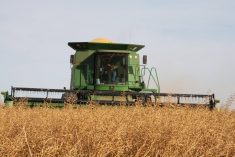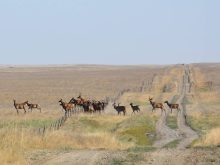SASKATOON – Too many farmers “willfully kill off” the business they love by not planning for its future, say two insurance company representatives.
The family farm that Grandpa started is usually gone by his great-grandchildren’s time, said Patrick Power of Manulife Financial. The fourth generation loses it by sale, disinterest or lack of financing.
Speaking to a meeting of Saskatchewan Farmers with Disabilities, Power said: “The average farmer will spend 100,000 hours in his farm business, but less than 10 hours planning for its future.”
Cash eases any plan and Power’s associate, Mike Topola, said farmers commonly use three sources to get money when they retire. The first is to sell the farm either outright or gradually over time. The trouble with this is that a forced sale can bring a lower price and tax implications. Also, inflation can take a big bite out of the money generated.
Read Also

Bunge’s crop mix is changing
Bunge has predominantly been a soybean processing firm, but that’s about to change after the merger with Viterra with softseed processing and grain merchandising gaining ground.
Borrowing is the most common but most costly way to raise cash. It is stressful to meet the regular payments and the loss of a key person on the farm through illness or accident means the loan may be called.
The third route to get money is to save it from the business, but Topola said most people can’t sit on a cash pile so they end up recycling it back into the farm.
Power said the smart way to transfer the farm to the next generation is to use a life insurance policy on the farm manager that will pay cash to all the children upon his or her death. It simplifies the process of settling the estate and reduces taxes, he said. It also helps the child who is going to continue the farm. He or she doesn’t have to worry about siblings interfering in the business because they have been paid an equivalent share in cash.
Topola said this type of planning is just now being introduced to farmers so only about 10 percent have such policies.
“A three percent premium on half a million dollars is still a pretty good deal compared to a mortgage or bank loan. It’s a simple way to leverage a lot of money.”
However, another speaker at the conference, Grant Anderson, outlined what his employer, the Farm Credit Corporation, can offer farmers to assist the intergenerational transfer. The federal lending agency came up with a family farm loan, based on an idea from a Moose Jaw area farmer.
The farm loan can be offered to relatives or to unrelated people. It requires a 10 percent down payment from the buyer with regular payments out of the farm’s cash flow.
The first mortgage is held by the FCC and the farm seller takes a second mortgage. But the seller also gets 40 percent of the price right away.
Anderson said the seller gets money sooner with little risk. The buyer gets to pay the farm loan off more quickly and doesn’t have to put up additional security.
“This is one way to transfer the farm without tying up a chunk of land or other security. (But) The buyer must have the down payment and the cash flow.”
Land versus cash
Anderson also counselled farmers planning to share the farm among their children to consider that the one with the land is often in a worse position than the one who gets a cash payment.
“A dollar’s worth of land is not worth a dollar in cash. Land is not trading at productive value right now. It’s overvalued. … Think about the viability of the farm if you give a quarter of land here and a quarter there.”
He also advised them to start planning now, no matter how old their children. And talk to a lawyer and accountant to understand the implications and whether the farm can survive the debt on it.
“You’ve got less options and you’ll pay more tax if you wait until you’re 64 and have had a heart attack.”














